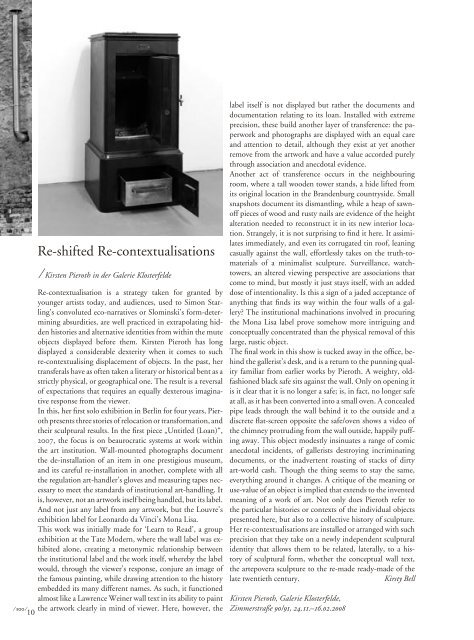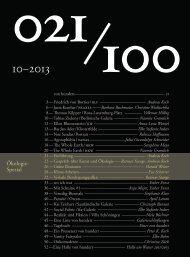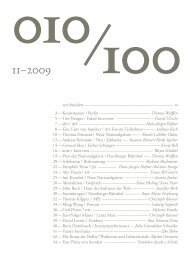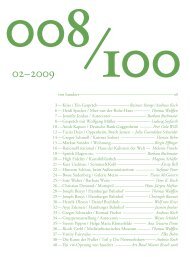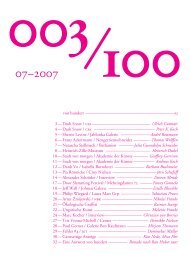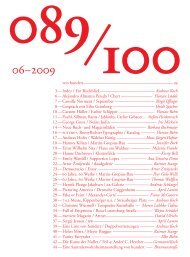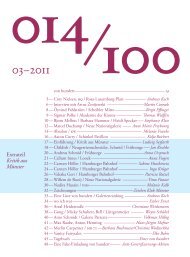Ausgabe 02-2008 als PDF vonhundert_2008-02_komplett.pdf
Ausgabe 02-2008 als PDF vonhundert_2008-02_komplett.pdf
Ausgabe 02-2008 als PDF vonhundert_2008-02_komplett.pdf
Erfolgreiche ePaper selbst erstellen
Machen Sie aus Ihren PDF Publikationen ein blätterbares Flipbook mit unserer einzigartigen Google optimierten e-Paper Software.
⁄ 100 ⁄ 10<br />
Re-shifted Re-contextualisations<br />
⁄ Kirsten Pieroth in der Galerie Klosterfelde<br />
Re-contextualisation is a strategy taken for granted by<br />
younger artists today, and audiences, used to Simon Starling’s<br />
convoluted eco-narratives or Slominski’s form-determining<br />
absurdities, are well practiced in extrapolating hidden<br />
histories and alternative identities from within the mute<br />
objects displayed before them. Kirsten Pieroth has long<br />
displayed a considerable dexterity when it comes to such<br />
re-contextualising displacement of objects. In the past, her<br />
transfer<strong>als</strong> have as often taken a literary or historical bent as a<br />
strictly physical, or geographical one. The result is a reversal<br />
of expectations that requires an equally dexterous imaginative<br />
response from the viewer.<br />
In this, her first solo exhibition in Berlin for four years, Pieroth<br />
presents three stories of relocation or transformation, and<br />
their sculptural results. In the first piece „Untitled (Loan)“,<br />
2007, the focus is on beaurocratic systems at work within<br />
the art institution. Wall-mounted photographs document<br />
the de-installation of an item in one prestigious museum,<br />
and its careful re-installation in another, complete with all<br />
the regulation art-handler’s gloves and measuring tapes necessary<br />
to meet the standards of institutional art-handling. It<br />
is, however, not an artwork itself being handled, but its label.<br />
And not just any label from any artwork, but the Louvre’s<br />
exhibition label for Leonardo da Vinci’s Mona Lisa.<br />
This work was initially made for ‘Learn to Read’, a group<br />
exhibition at the Tate Modern, where the wall label was exhibited<br />
alone, creating a metonymic relationship between<br />
the institutional label and the work itself, whereby the label<br />
would, through the viewer’s response, conjure an image of<br />
the famous painting, while drawing attention to the history<br />
embedded its many different names. As such, it functioned<br />
almost like a Lawrence Weiner wall text in its ability to paint<br />
the artwork clearly in mind of viewer. Here, however, the<br />
label itself is not displayed but rather the documents and<br />
documentation relating to its loan. Installed with extreme<br />
precision, these build another layer of transference: the paperwork<br />
and photographs are displayed with an equal care<br />
and attention to detail, although they exist at yet another<br />
remove from the artwork and have a value accorded purely<br />
through association and anecdotal evidence.<br />
Another act of transference occurs in the neighbouring<br />
room, where a tall wooden tower stands, a hide lifted from<br />
its original location in the Brandenburg countryside. Small<br />
snapshots document its dismantling, while a heap of sawnoff<br />
pieces of wood and rusty nails are evidence of the height<br />
alteration needed to reconstruct it in its new interior location.<br />
Strangely, it is not surprising to find it here. It assimilates<br />
immediately, and even its corrugated tin roof, leaning<br />
casually against the wall, effortlessly takes on the truth-tomateri<strong>als</strong><br />
of a minimalist sculpture. Surveillance, watchtowers,<br />
an altered viewing perspective are associations that<br />
come to mind, but mostly it just stays itself, with an added<br />
dose of intentionality. Is this a sign of a jaded acceptance of<br />
anything that finds its way within the four walls of a gallery?<br />
The institutional machinations involved in procuring<br />
the Mona Lisa label prove somehow more intriguing and<br />
conceptually concentrated than the physical removal of this<br />
large, rustic object.<br />
The final work in this show is tucked away in the office, behind<br />
the gallerist’s desk, and is a return to the punning quality<br />
familiar from earlier works by Pieroth. A weighty, oldfashioned<br />
black safe sits against the wall. Only on opening it<br />
is it clear that it is no longer a safe; is, in fact, no longer safe<br />
at all, as it has been converted into a small oven. A concealed<br />
pipe leads through the wall behind it to the outside and a<br />
discrete flat-screen opposite the safe/oven shows a video of<br />
the chimney protruding from the wall outside, happily puffing<br />
away. This object modestly insinuates a range of comic<br />
anecdotal incidents, of gallerists destroying incriminating<br />
documents, or the inadvertent roasting of stacks of dirty<br />
art-world cash. Though the thing seems to stay the same,<br />
everything around it changes. A critique of the meaning or<br />
use-value of an object is implied that extends to the invented<br />
meaning of a work of art. Not only does Pieroth refer to<br />
the particular histories or contexts of the individual objects<br />
presented here, but <strong>als</strong>o to a collective history of sculpture.<br />
Her re-contextualisations are installed or arranged with such<br />
precision that they take on a newly independent sculptural<br />
identity that allows them to be related, laterally, to a history<br />
of sculptural form, whether the conceptual wall text,<br />
the artepovera sculpture to the re-made ready-made of the<br />
late twentieth century. Kirsty Bell<br />
Kirsten Pieroth, Galerie Klosterfelde,<br />
Zimmerstraße 90/91, 24.11.–16.<strong>02</strong>.<strong>2008</strong>


